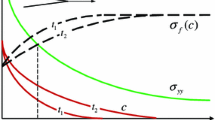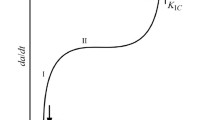Abstract
In Part 1 of this work it was shown that, because of the coupling of the processes of crack growth and hydrogen accumulation in rupture sites, the crack growth kinetics curve v= v(K) in hydrogen assisted cracking (HAC) does not possess intrinsic uniqueness as a material's characteristic curve. This paper presents an analytical treatment of the phenomenon and a special regime of steady-state crack growth is seen to exist for which hydrogen assisted cracking turns out to be a K-dominated process. The corresponding plot of the steady-state v against K acquires the uniqueness of a material's characteristic curve which may be used in engineering to provide more conservative evaluation of material resistance and structural integrity in HAC conditions. Inherent uncertainties in the customary fracture mechanics approach to HAC are analysed in an attempt to guide the way towards its further refinement.
Similar content being viewed by others
References
Ahmad, J. and Ashbaugh, N.E. (1982). Constant K I crack propagation test specimens. International Journal of Fracture 19, 115–129.
Atluri, S.N. and Kobayashi, A.S. (1986). Elastic-plastic fracture (Quasi-static). Computational Methods in Mechanics. Vol. 2: Computational Methods in the Mechanics of Fracture (Edited by S.N. Atluri), Elsevier, Amsterdam, 55–83.
Gangloff, R.P. (1988). Crack tip modelling of hydrogen environment embrittlement: Application to fracture mechanics life prediction. Materials Science and Engineering A 103, 157–166.
Hudak, Jr., S.J. and Wei, R.P. (1979). Consideration of nonsteady state crack growth in materials evaluation and design. Structural Mechanics in Reactor Technology. Transaction 5th International Conference, Berlin, 1979. Amsterdam, G5/5 1–7.
Kanninen, M.F. and Popelar, C.H. (1985). Advanced Fracture Mechanics. Oxford University Press, New York.
Kramer, I. and Hirth, J.P. (1984). Effect of hydrogen on the dislocation density distribution in 1090 steel. Scripta Metallurgica 18, 539–541.
Kronshtal, O.V. and Kharin, V.S. (1992). Effect of heterogeneity of materials and of heat cycles on diffusion of hydrogen as a factor of risk of development of hydrogen degradation of metals. Soviet Materials Science 28, 475–486.
Kummick, A.J. and Johnson, H.H. (1980). Deep trapping states for hydrogen in deformed iron. Acta Metallurgica 28, 33–39.
Landes, J.D. and Wei, R.P. (1973). The kinetics of subcritical crack growth under sustained loading. International Journal of Fracture 9, 277–293.
McClintock, F.A. (1971). Plasticity aspects of fracture. Fracture. An Advanced Treatise. Vol. 3 (Edited by H. Liebowitz), Academic Press, New York, 48–264.
McMeeking, R.M. (1977). Finite deformation analysis of crack tip opening in elastic-plastic materials and implications for fracture. Journal of the Mechanics and Physics of Solids 25, 357–381.
McMeeking, R.M. and Parks, D.M. (1979). On criteria for J-dominance of crack-tip fields in large-scale yielding. Elastic-Plastic Fracture, ASTM STP 668 (Edited by J.D. Landes, J.A. Begley and G.A. Clarke), ASTM, Philadelphia, 175–194.
Narasimhan, R. (1994). A numerical study of fracture initiation in a ductile material containing dual population of second-phase particles. — I. Static loading. Engineering Fracture Mechanics 47, 919–934.
Needleman, A. and Tvergaard, V. (1983). Crack-tip stress and deformation fields in a solid with a vertex on its yield surface. Elastic-Plastic Fracture: Second Symposium. Vol. 1 — Inelastic Crack Analysis. ASTM STP 803 (Edited C.F. Shih and J.P. Gudas), ASTM, Philadelphia, I-80–I-115.
Onyewuenyi, O.A. (1985). Plastic instability and hydrogen in iron-based alloys. Hydrogen Degradation of Ferrous Alloys, Noyes Publishers, Park Ridge, 414–453.
Panasyuk, V.V. and Kharin, V. (1990). The influence of hydrogenating environments on crack propagation in metals. Environment Assisted Fatigue (Edited by P. Scott and R.A. Cottis), London, Mechanical Engineering Publications, 123–144.
Shih, C.F. (1981). Relationships between the J-integral and the crack opening displacement for stationary and extending cracks. Journal of the Mechanics and Physics of Solids 29, 305–326.
Shih, C.F., de Lorenzi, H.G. and Andrews, W.G. (1979). Studies on crack initiation and stable crack growth. Elastic-Plastic Fracture. ASTM STP 668 (Edited J.D. Landes, J.A. Begley and G.A. Clarke), ASTM, Philadelphia, 65–120.
Sorensen, E.P. (1979). A numerical investigation of plane strain stable growth under small-scale yielding conditions. Elastic-Plastic Fracture. ASTM STP 668 (Edited by J.D. Landes, J.A. Begley and G.A. Clarke), ASTM, Philadelphia, 151–174.
Toribio, J. and Kharin, V. (1996). Predictive capability of fracture mechanics concerning environmentally assisted cracking. InterCorr/96 — 1st Global Internet Corrosion Conference held on ‘The Materials and Corrosion Technology Web Site’. Archived at URL http://www.intercorr.com.
Toribio, J. and Kharin, V. (1997). K-dominance condition in hydrogen-assisted cracking: the role of far field. Fatigue and Fracture of Engineering Materials and Structures 20, 729–745.
Toribio, J. and Kharin, V. (1998). The effect of history on hydrogen assisted cracking: 1. Coupling of hydrogenation and crack growth. International Journal of Fracture this issue, 233–245.
Turnbull, A. (1992). Test methods for environment assisted cracking. British Corrosion Journal 27, 271–289.
Tvergaard, V. and Hutchinson, J.W. (1992). The relation between crack growth resistance and fracture process parameters in elastic-plastic solids. Journal of the Mechanics and Physics of Solids 40, 1377–1397.
Author information
Authors and Affiliations
Additional information
On leave from: Pidstryhach Institute of Applied Mechanics and Mathematics, Lviv, Ukraine
Rights and permissions
About this article
Cite this article
Toribio, J., Kharin, V. The Effect of History on Hydrogen Assisted Cracking: 2. A revision of K-dominance. International Journal of Fracture 88, 247–258 (1997). https://doi.org/10.1023/A:1007402301554
Issue Date:
DOI: https://doi.org/10.1023/A:1007402301554




